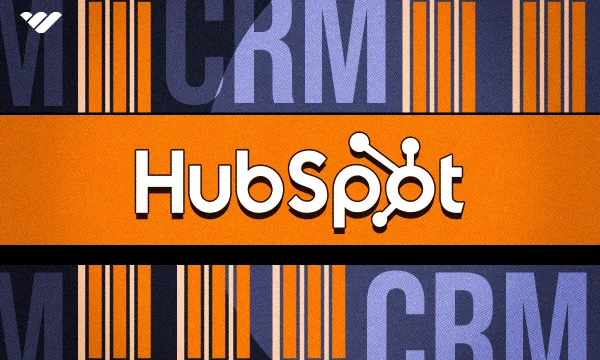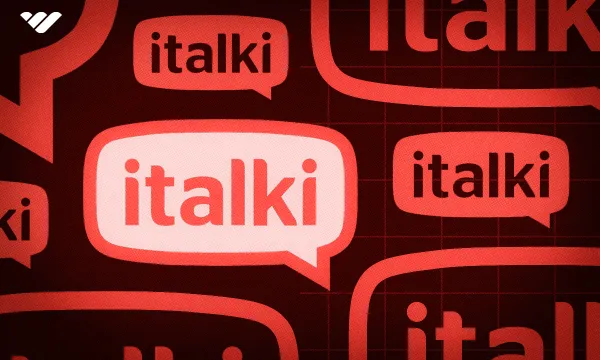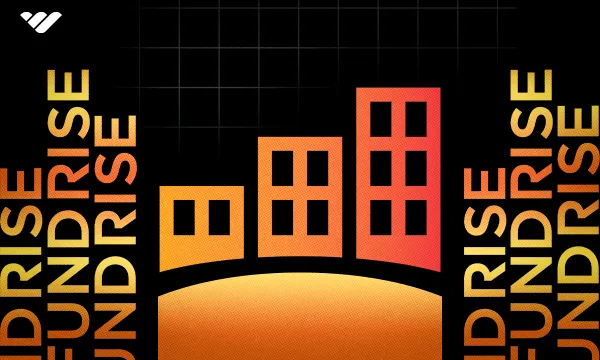A customer relationship management (CRM) platform can help centralize your business's most important sales and marketing information. You can use it to manage leads, maintain customer relationships, and organize client-related data.
HubSpot CRM is a highly sought-after CRM tool, with more than 228,000 customers currently using the platform. What makes it stand out, and how does it help businesses retain customers and get more leads?
This detailed review examines HubSpot CRM’s main features, pricing plans, strengths, and weaknesses. We also show you how to get started on the platform and review how it compares to competitors. We will help you decide if HubSpot CRM aligns with your business needs.
Let's dive in.
What is HubSpot CRM?
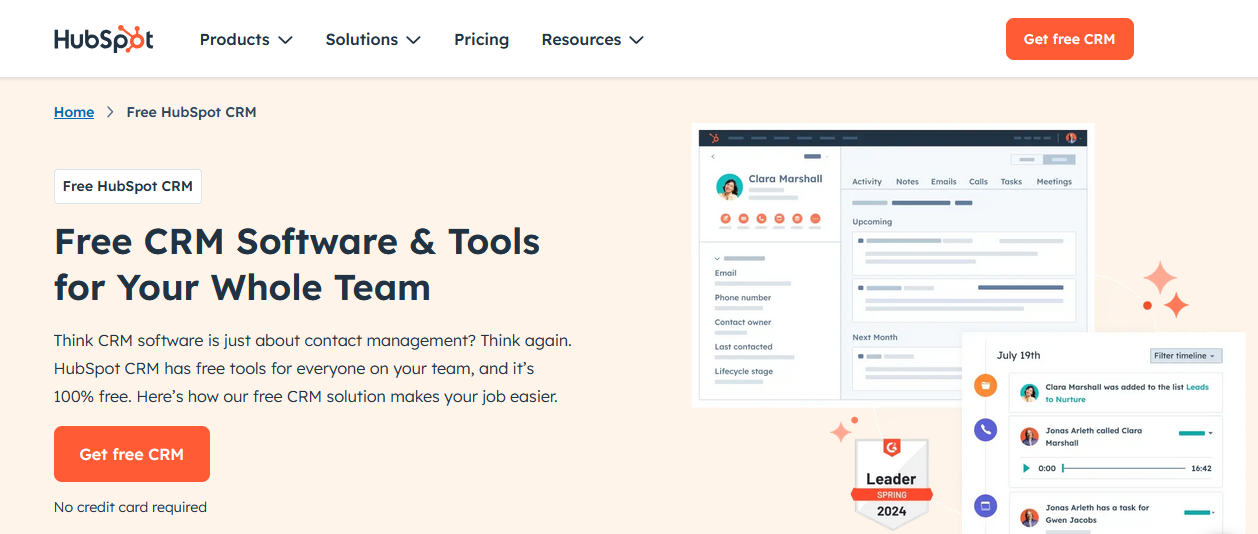
HubSpot CRM is a cloud-based customer relationship management platform that enables businesses of all sizes to manage leads and customer relationships. Companies use HubSpot CRM for lead management, client support, maintaining vital customer information, and related functions.
The whole point of HubSpot CRM is to make businesses function better.
The HubSpot CRM platform centralizes customer details and provides advanced business insights that help you understand how your business is performing and where you can improve. These insights help you make crucial business decisions.
Data centralization combines all business data in one place, enabling quick access across teams and devices.
Let’s now examine whether you should include HubSpot CRM in your business strategy.
What can you do with HubSpot CRM?
Manage customer information
With HubSpot CRM, you can generate contact records and view customer interactions.
The software allows you to:
- Create and change contact records automatically
- Manage sales activities directly from a contact’s records
- Add customer details to the records at any time
You can create 1,000 customer contacts and company records on the free plan. This number goes up to 15 million if you are on a paid plan.
Track your users
Business owners can check customer activities from the customer’s timeline. HubSpot records customer engagements on their timeline. You can filter these engagements and create specialized reports.
Create pipelines
Another way you can use HubSpot is to create deal pipelines to visualize the sales process and forecast your revenue margins. You can also use these deal pipelines to anticipate and handle potential challenges.
Chat with customers
Modern customers want information, and they want it fast. With HubSpot CRM, you can access a live chat feature to engage website visitors. You can use this option to handle inquiries, qualify leads, and send welcome messages to potential customers.
Getting started with HubSpot CRM
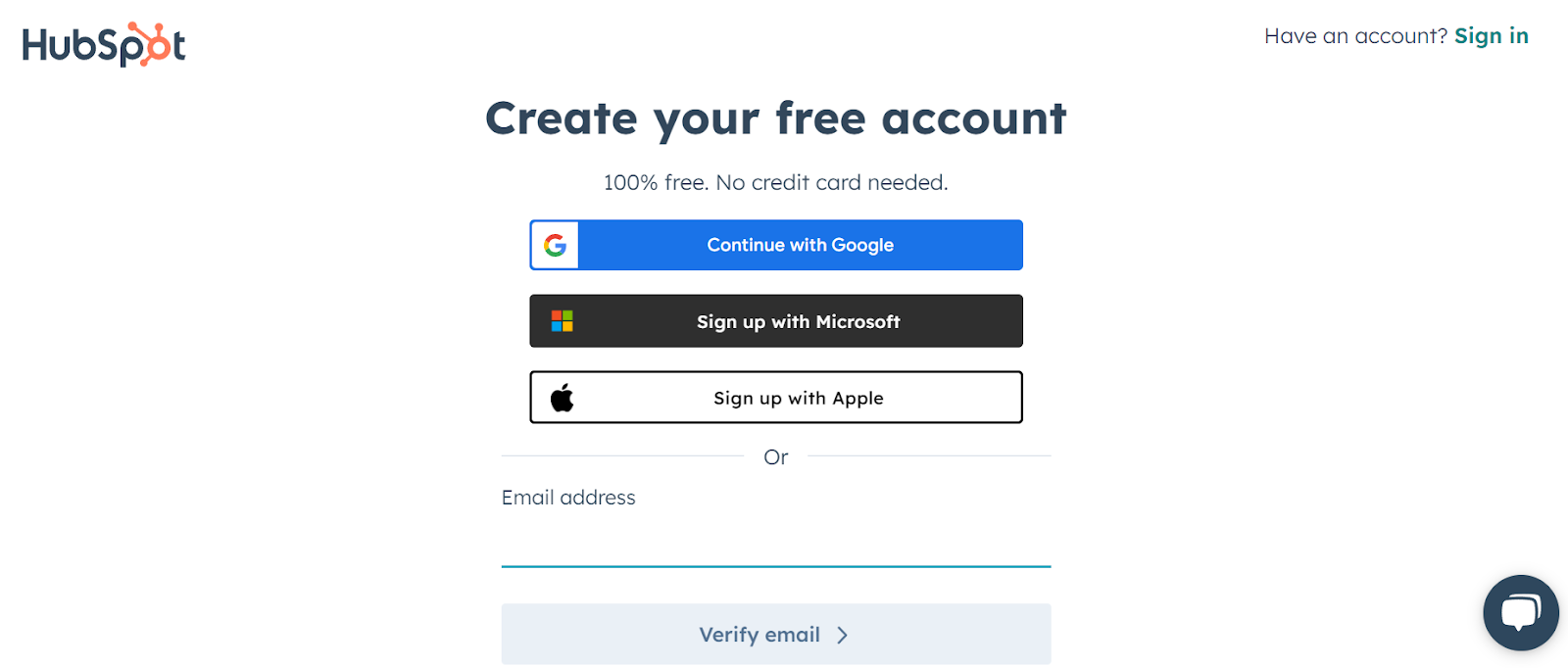
Signing up for HubSpot CRM is a straightforward process. Once you click that Sign Up button, the first step will involve choosing your company's primary industry.
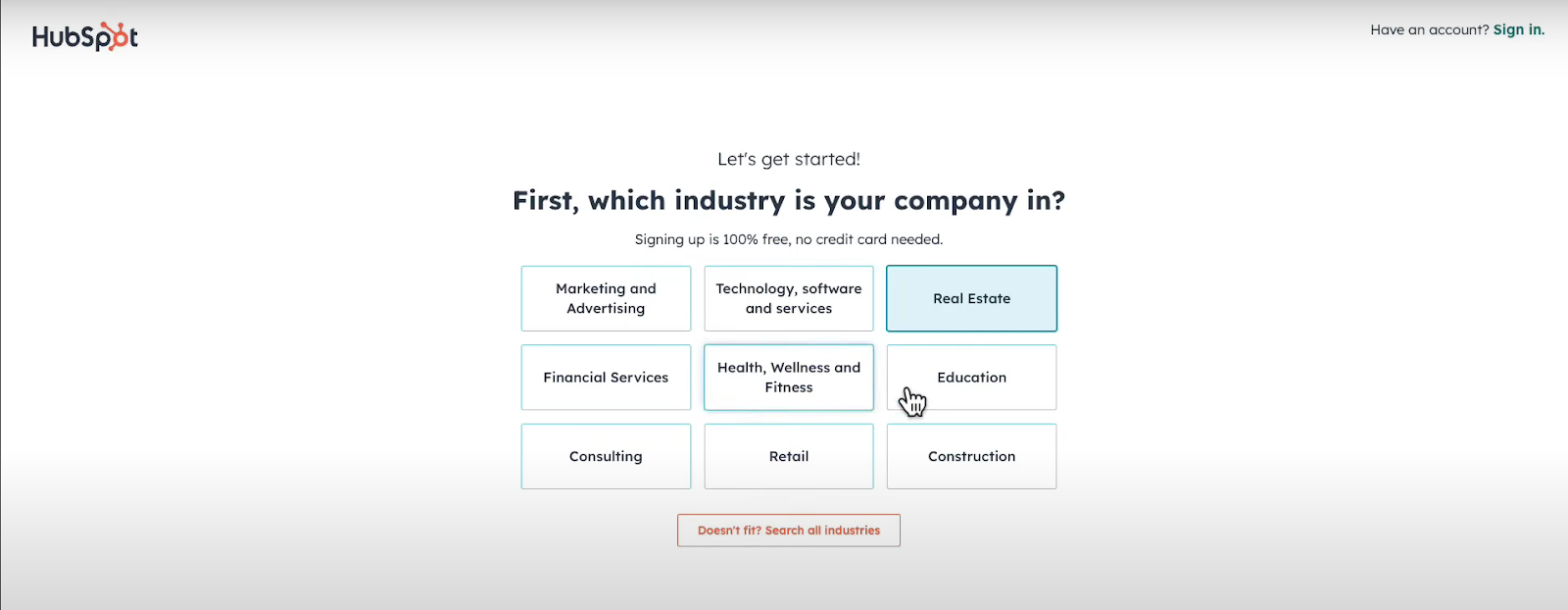
Subsequent prompts will inquire about the number of people in your company, your role as an owner, and what you plan on using HubSpot CRM for. You will then fill out your company name and domain and choose the location you want your data hosted.
We recommend being as accurate as possible since these prompts will help you choose the best plan for your organization.
After filling out these details, HubSpot will propose a template depending on your answers.
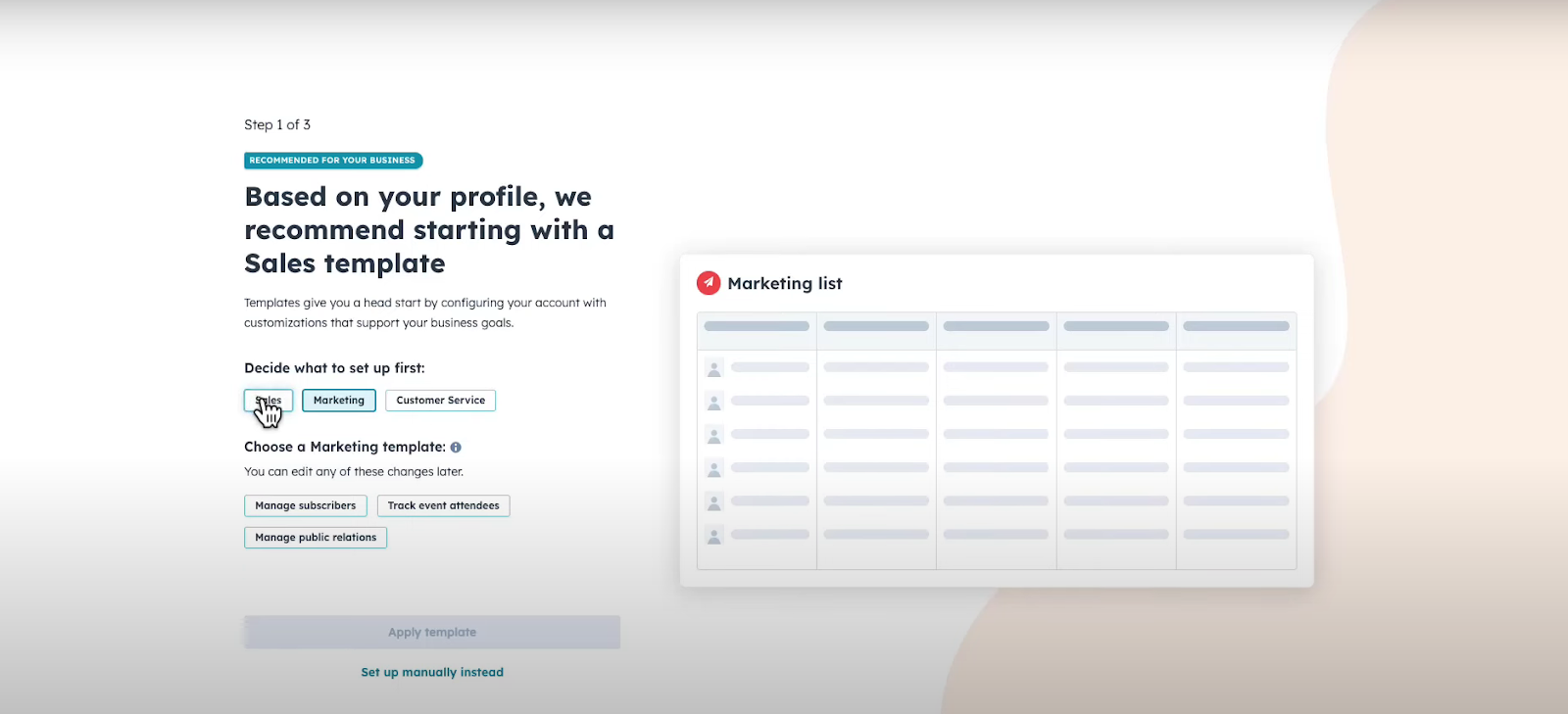
From there, you can add your contacts and team members, and start using some of the advanced HubSpot CRM features.
Use these HubSpot CRM features to manage your business
Automate your work on the Marketing Hub
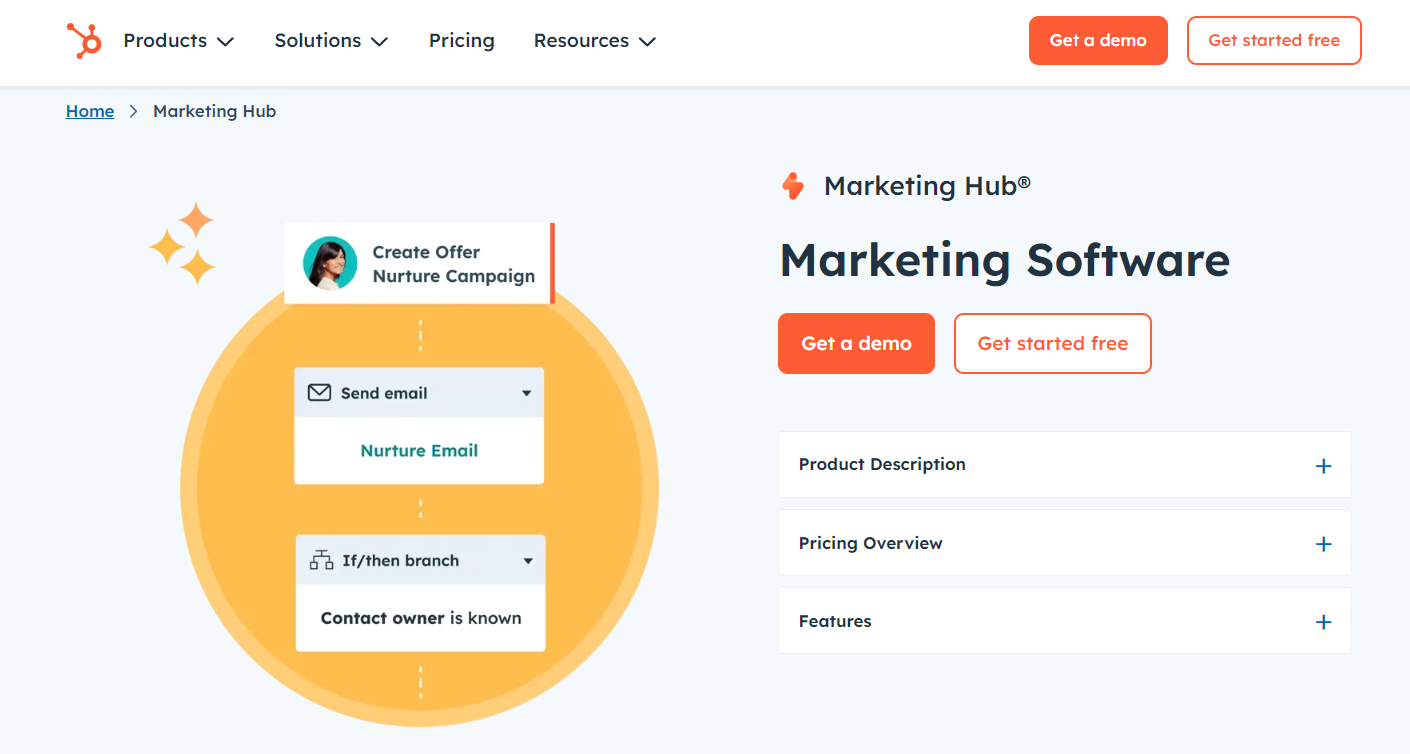
HubSpot’s marketing software enables business owners to generate leads and automate marketing campaigns. Once you sign up, you’ll find all the marketing tools and data in a central location.
Use these tools to create blogs, manage social media channels, run ads, and build your brand’s search authority. You can also create attractive landing pages for your business and monitor progress on the go.
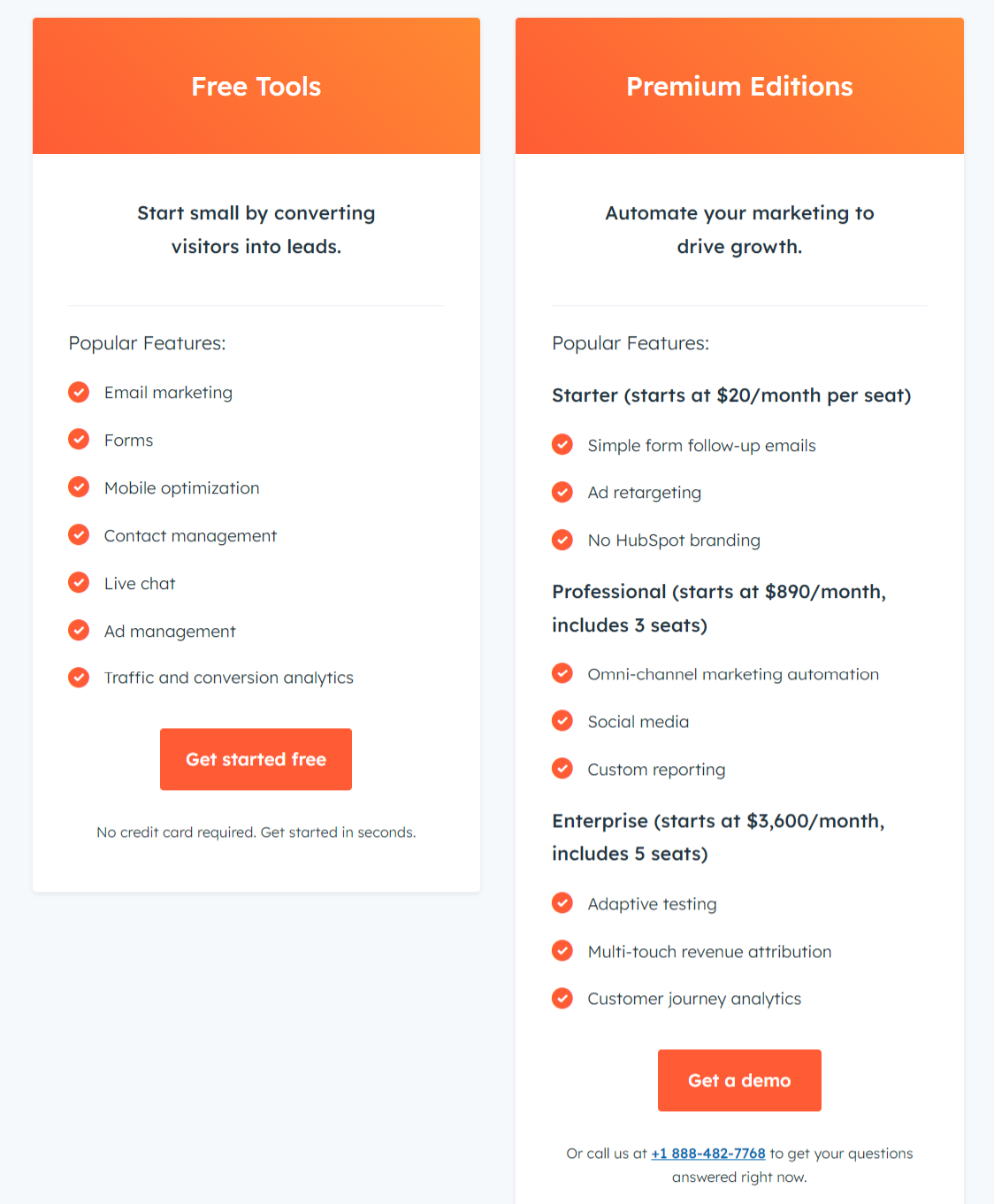
What you can access in the HubSpot Marketing Hub depends on your subscription plan. You do not have to pay anything for the free plan. However, the Starter plan goes for $20/user per month, the Professional plan is $890/month for three seats, while the Enterprise plan requires a $3,600/month subscription fee for five seats.
Sell more on the Sales Hub
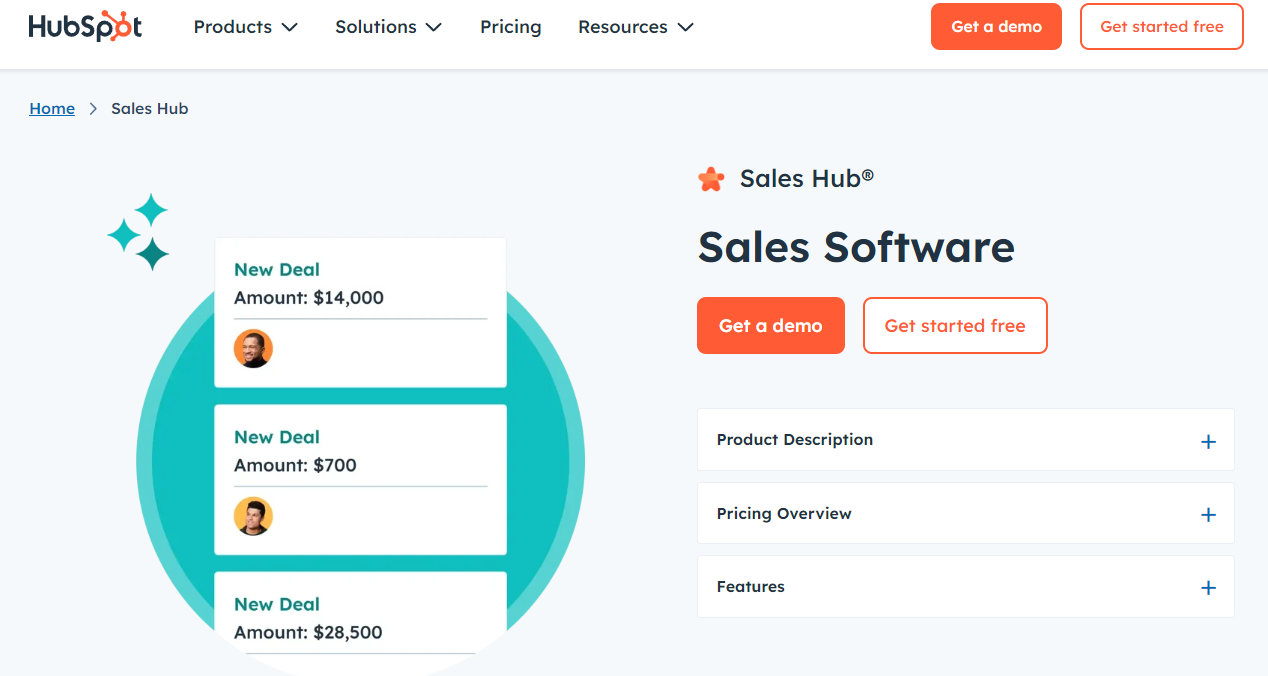
The HubSpot Sales Hub is a tool for building sales pipelines and closing deals. You can also use this feature to build stronger relationships with your customers and manage your sales pipelines to get the best returns for your products.
The free plan offers email tracking, document sharing, live chat support, meeting scheduling, and deal management. With these tools, your sales team can deliver a consistent brand message to all customers.
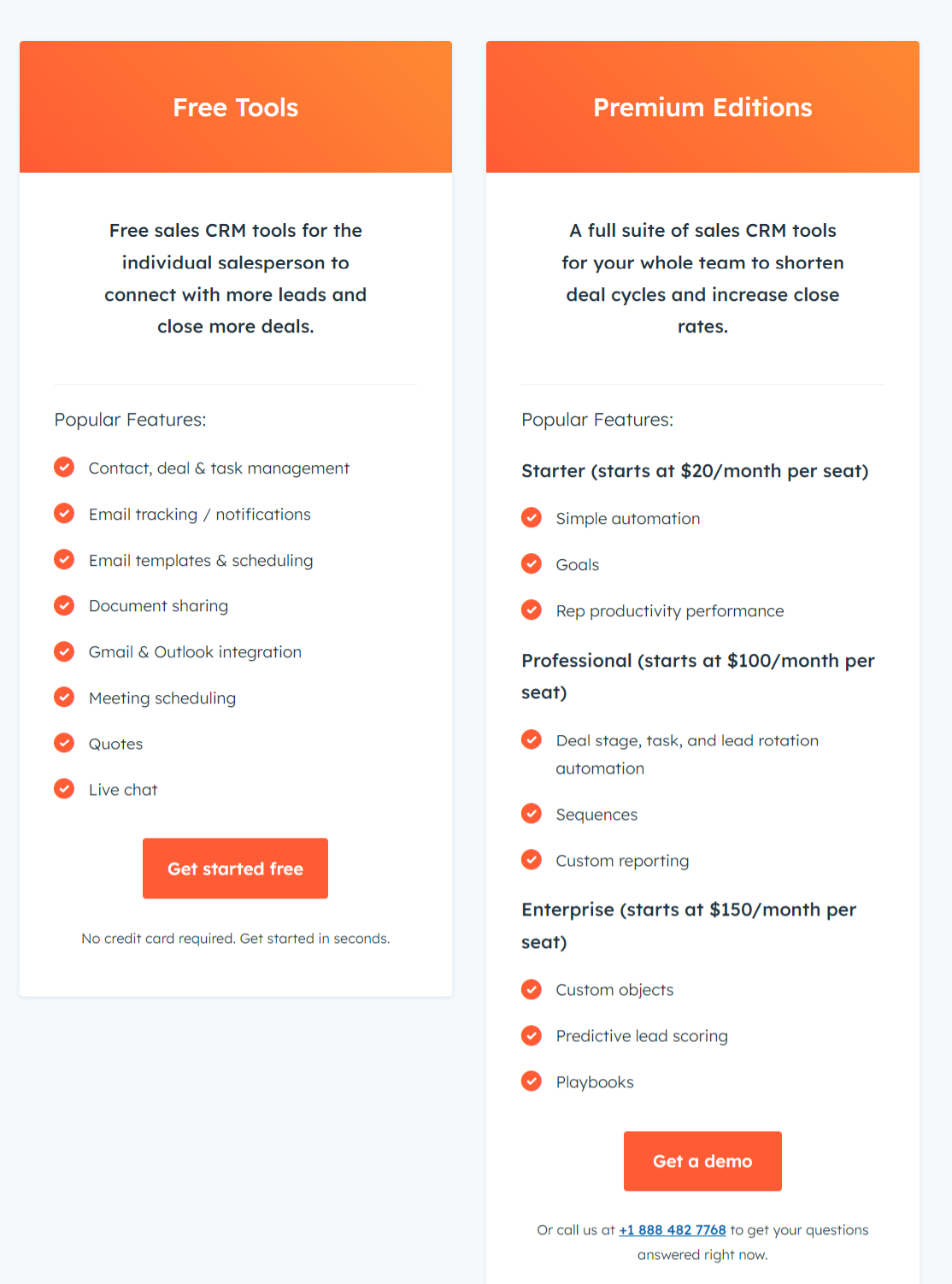
Here's a general overview of what you can do on the Sales Hub:
- Schedule meetings with prospective customers
- Pipeline management
- Automate and personalize entire sales processes
- Allocate live chat conversations to relevant salespersons
The Sales Hub provides all the features you could ask for in a CRM system. It is also tiered as follows:
- Free plan - $0
- Starter plan - $20/user per month
- Professional plan - $100/user per month
- Enterprise plan - $150/user per month
Improve retention through the Service Hub
As the name suggests, the HubSpot Service Hub is all about enhancing customer service. This AI-powered platform helps you increase customer retention — all you have to do is customize it to deliver maximum customer value.
The Service Hub works across multiple business channels and can connect to the Marketing and Sales Hubs. It provides a proactive and scalable customer retention framework that propels business growth.
Here's what you can do on the Service Hub:
- Manage tickets and resolve issues quickly
- Receive and track customer calls
- Manage your support team
- Communicate with your customers
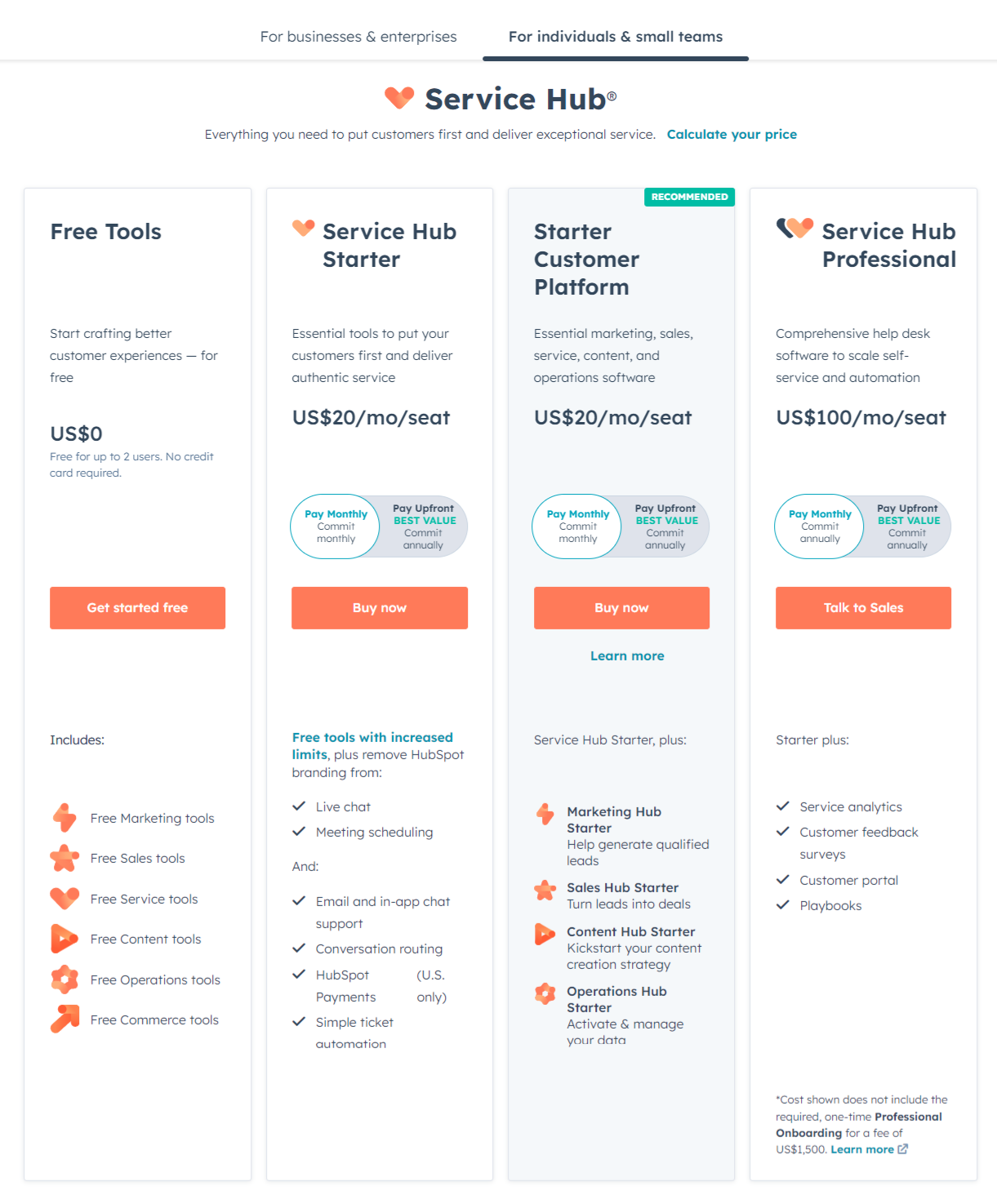
There are pricing plans for individuals/small teams and businesses/enterprises.
For individuals and small teams:
- Free plan - $0/month
- Service Hub Starter - $20/month/seat
- Starter Customer Platform - $20/month/seat
- Service Hub Professional - $100/month/seat
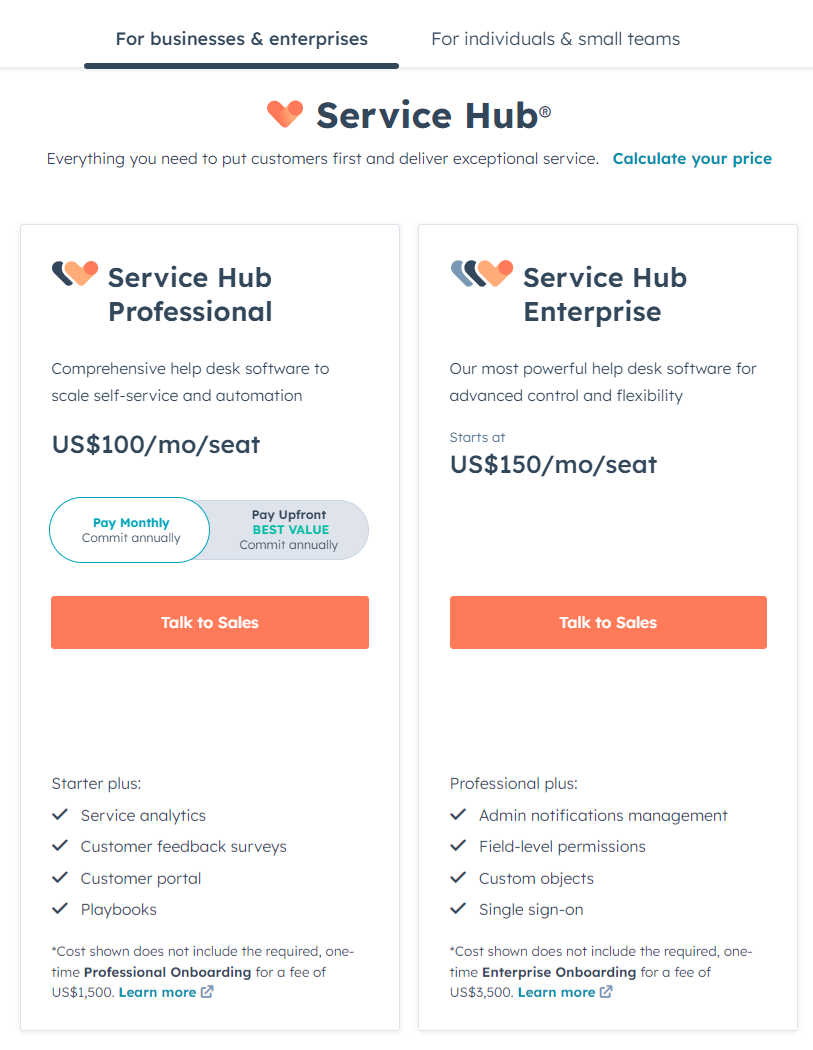
For businesses and enterprises:
- Service Hub Professional - $100/month/seat
- Service Hub Enterprise - $150/month/seat
Get creative on the Content Hub
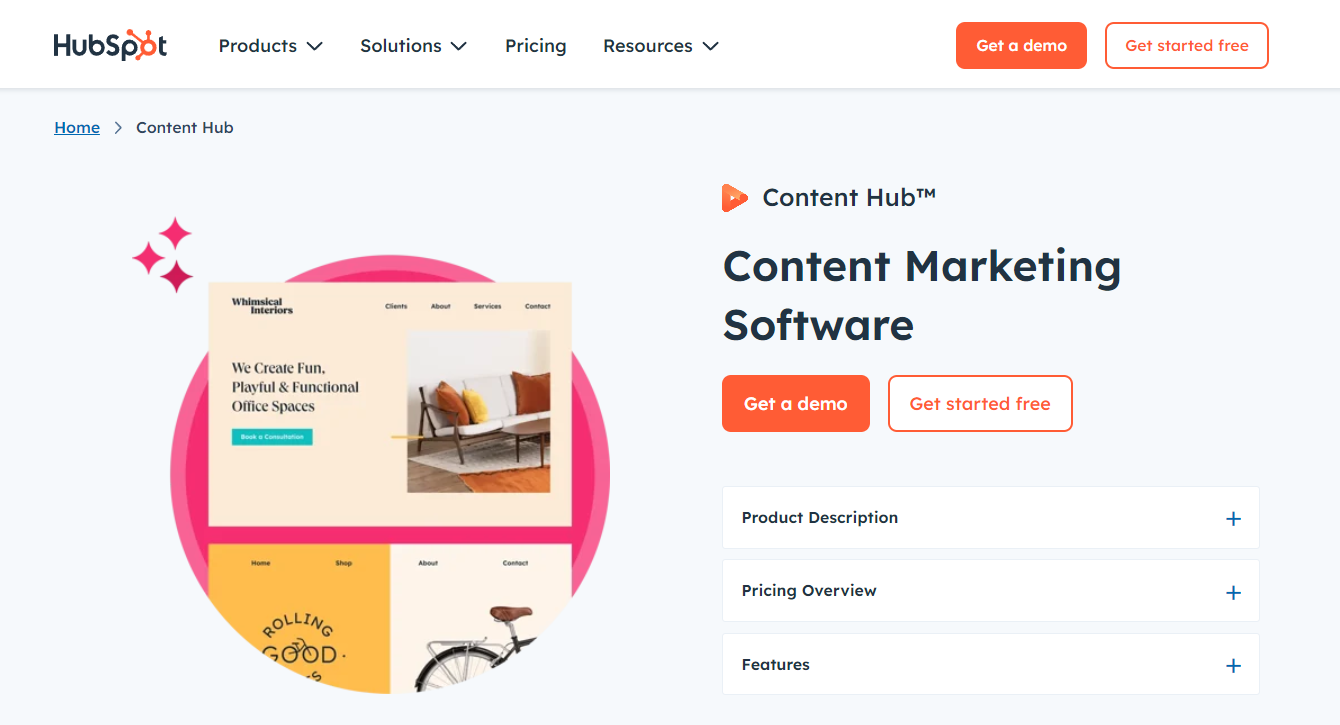
HubSpot has designed the Content Hub (previously known as the CMS Hub) to be a place where users create and manage user-centric content. The Content Hub has many features, such as image generation, an AI blog post generator, a content remixer, a website assistant, and a landing page builder. These are just a few mentions.
The new Content Hub is AI-powered, meaning you can quickly create large amounts of content. You can use this content anywhere along the customer journey and personalize it based on your audience and their immediate needs.
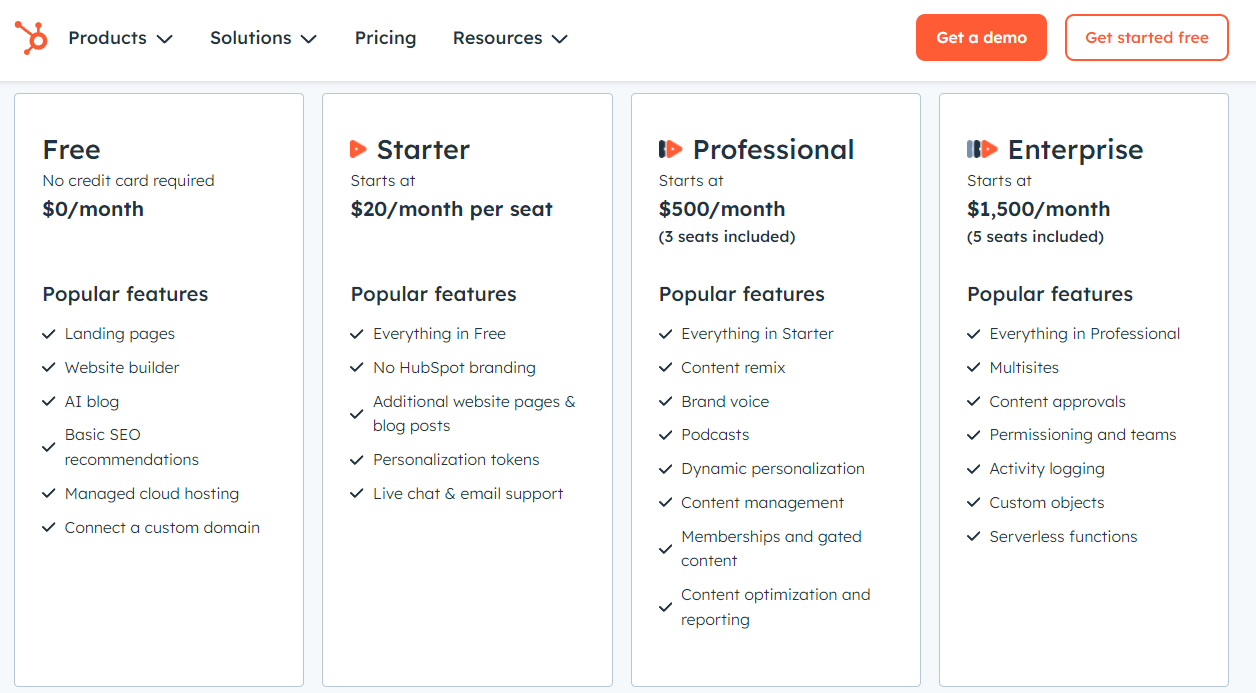
Here's how much HubSpot charges for the Content Hub:
- Free plan - $0/month
- Content Hub Starter - $20/month/seat
- Content Hub Professional - $500/month for three seats
- Content Hub Enterprise - $1500/month for five seats
Manage data on the Operations Hub
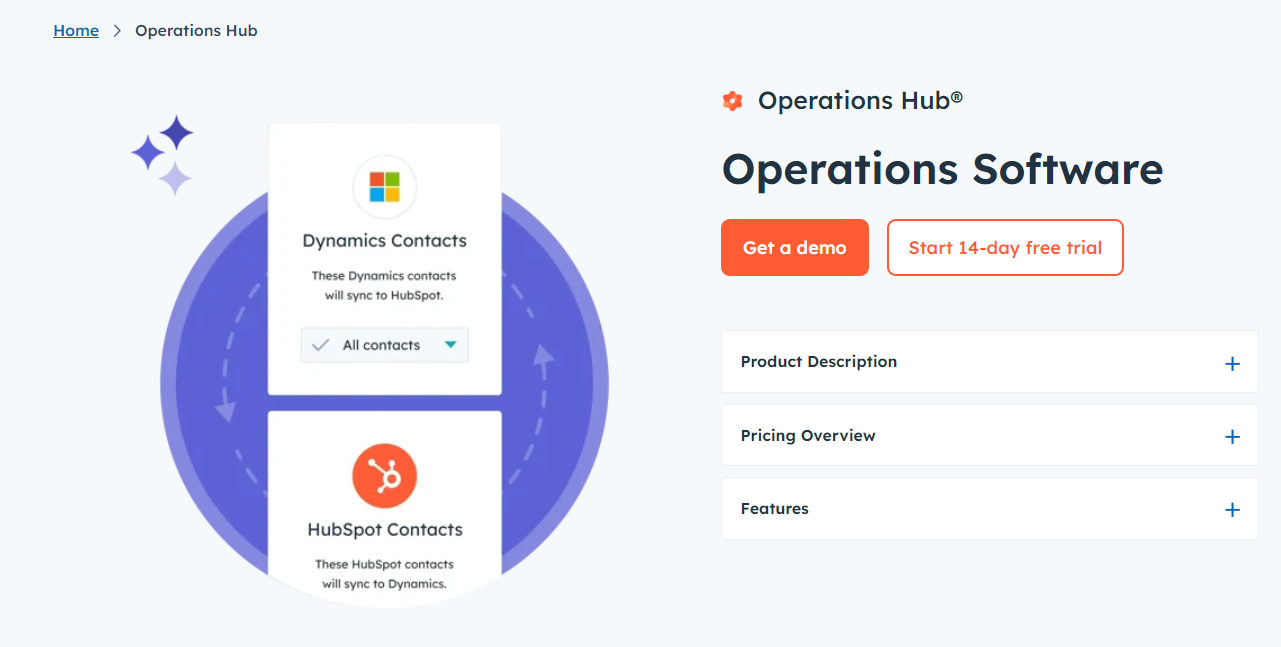
The Operations Hub connects your apps, cleans up customer data, compiles the data, and automates your business's processes.
Some popular functionalities on the Operations Hub include:
- Data synchronization
- Data quality automation
- Snowflake data share
- Custom report builder
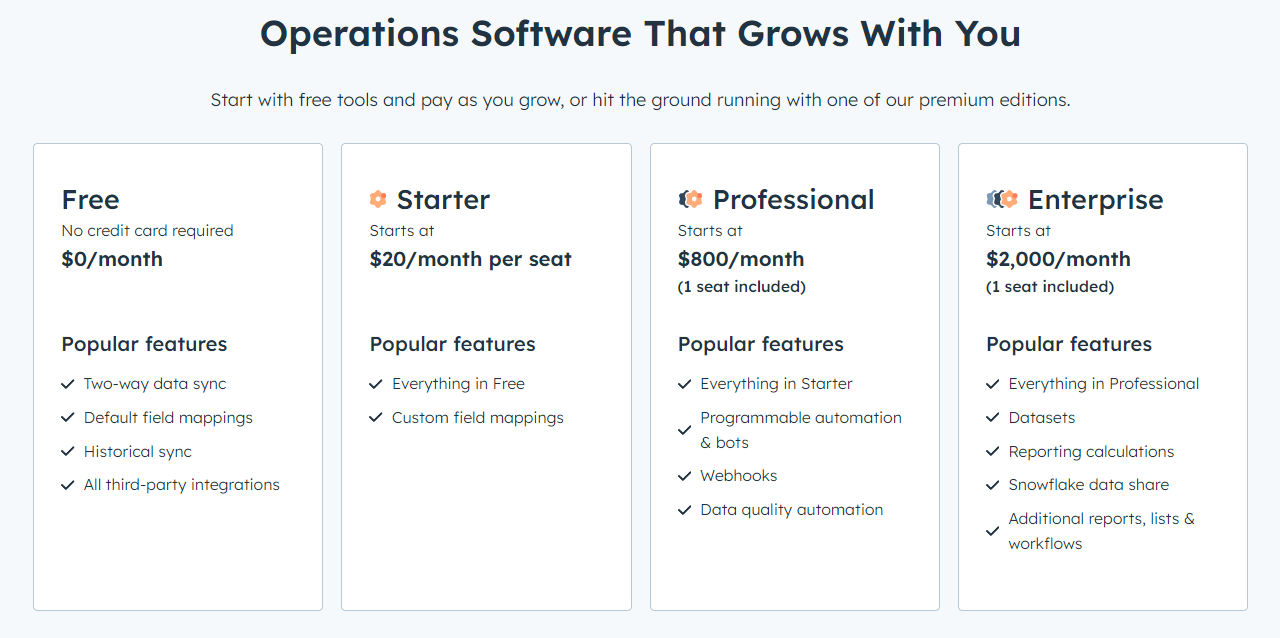
Here's how much HubSpot charges for the Operations Hub:
- Free plan - $0/month
- Operations Hub Starter - $20/month/seat
- Operations Hub Professional - $800/month for one seat
- Operations Hub Enterprise - $2500/month for one seat
Automate billing and invoicing on the Commerce Hub
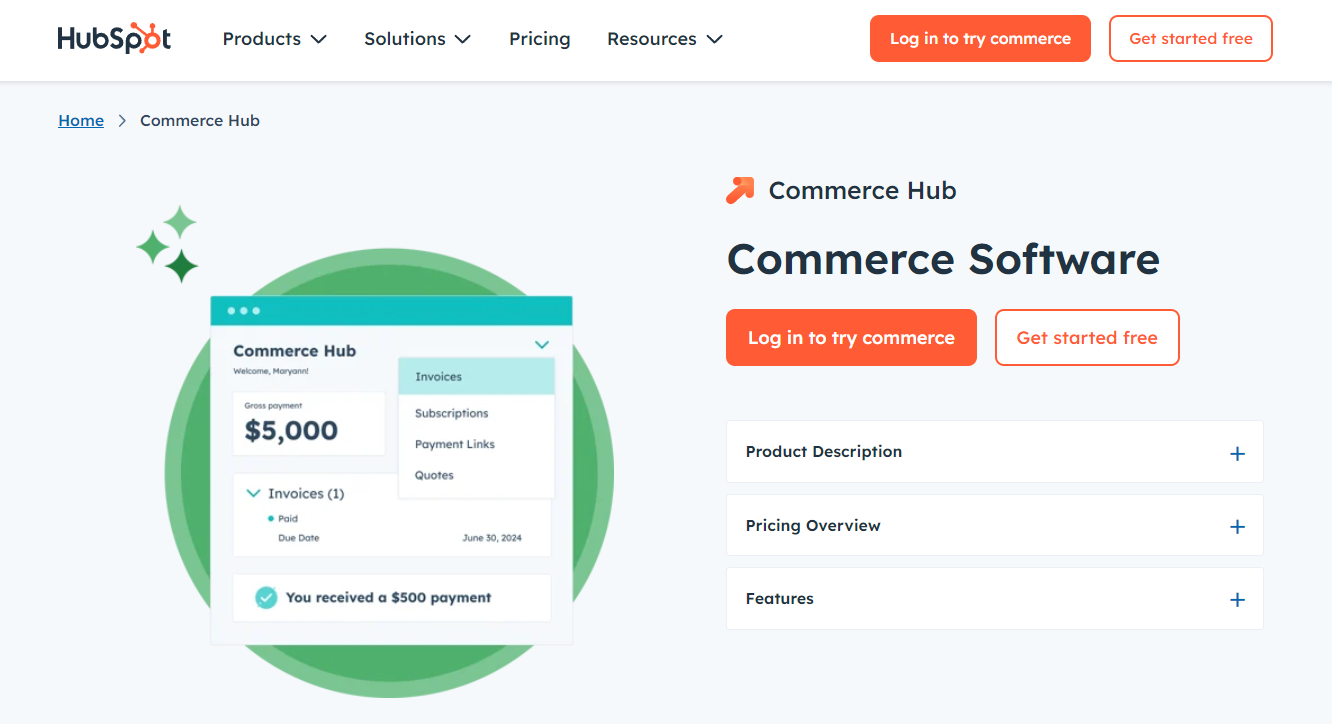
HubSpot has designed the Commerce Hub to help you receive payments faster, increase earnings, and save time.
This feature has no subscription charges, apart from the transaction fees that arise once you process your payments through the Commerce Hub.
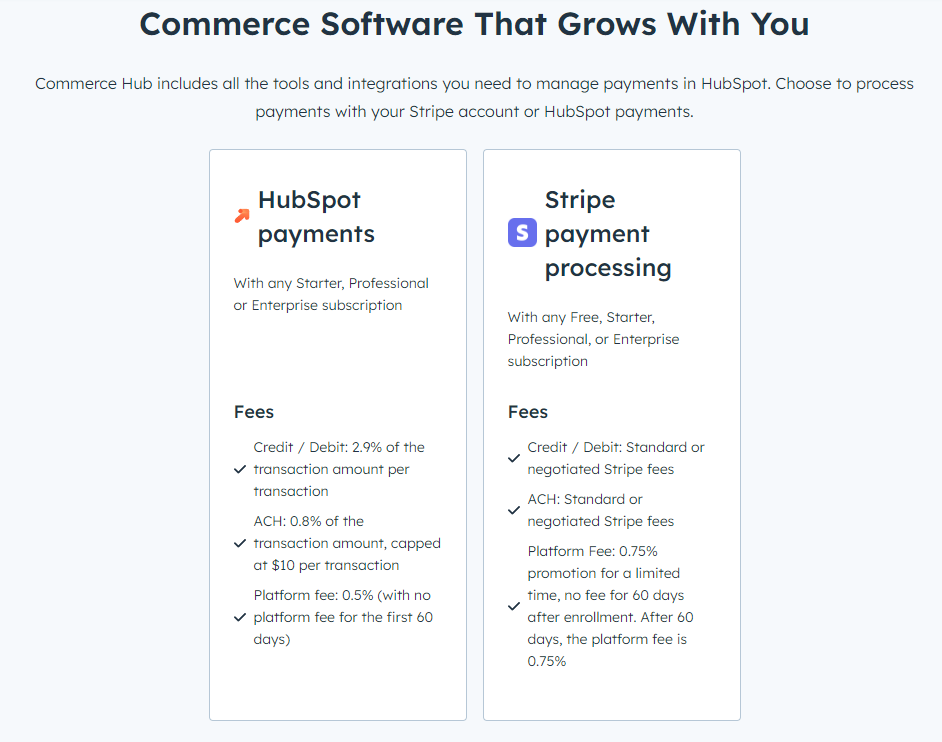
Here is an overview of the HubSpot payments pricing structure per transaction:
- A 0.5% platform fee
- A 2.9% fee for credit cards
- A 0.8% Automatic Clearing House (ACH) fee capped at $10
A 0.75% platform fee is charged per transaction when processing payments through Stripe. This fee is in addition to any processing fees charged directly by Stripe.
It is also worth noting that HubSpot payments only work for businesses in the United States. Stripe payment processing through the HubSpot Commerce Hub will work in most countries where Stripe is accepted, except India, Indonesia, Malaysia, Thailand, Ghana, Kenya, Nigeria, South Africa, Brazil, Croatia, Gibraltar, Lichtenstein, and the UAE.
How much does HubSpot CRM cost?
Now that you know the features HubSpot CRM provides, let's look at how much it will set you back.
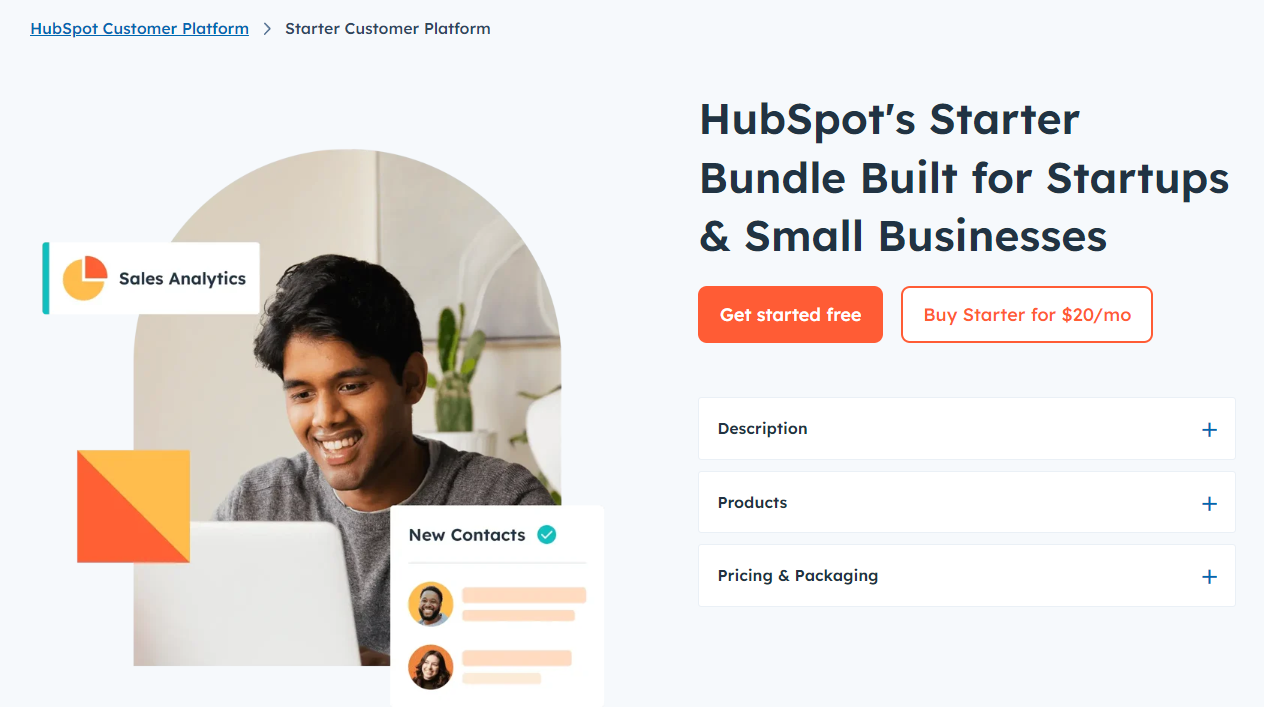
There are so many HubSpot packages and pricing tiers, making it difficult for most people to know what's best for their businesses. You can start by trying out the free tools, and then, once you're comfortable, select a bundle that best aligns with your business needs.
Since we're reviewing HubSpot as a customer relationship management (CRM) software, we recommend the HubSpot Customer Platform. This comprehensive option offers all the tools your business would need in a CRM: Marketing Hub Starter, Sales Hub Starter, Operations Hub Starter, Service Hub Starter, Content Hub Starter, and Commerce Hub.
You also get email and in-app chat support and up to 5,000 marketing emails monthly.
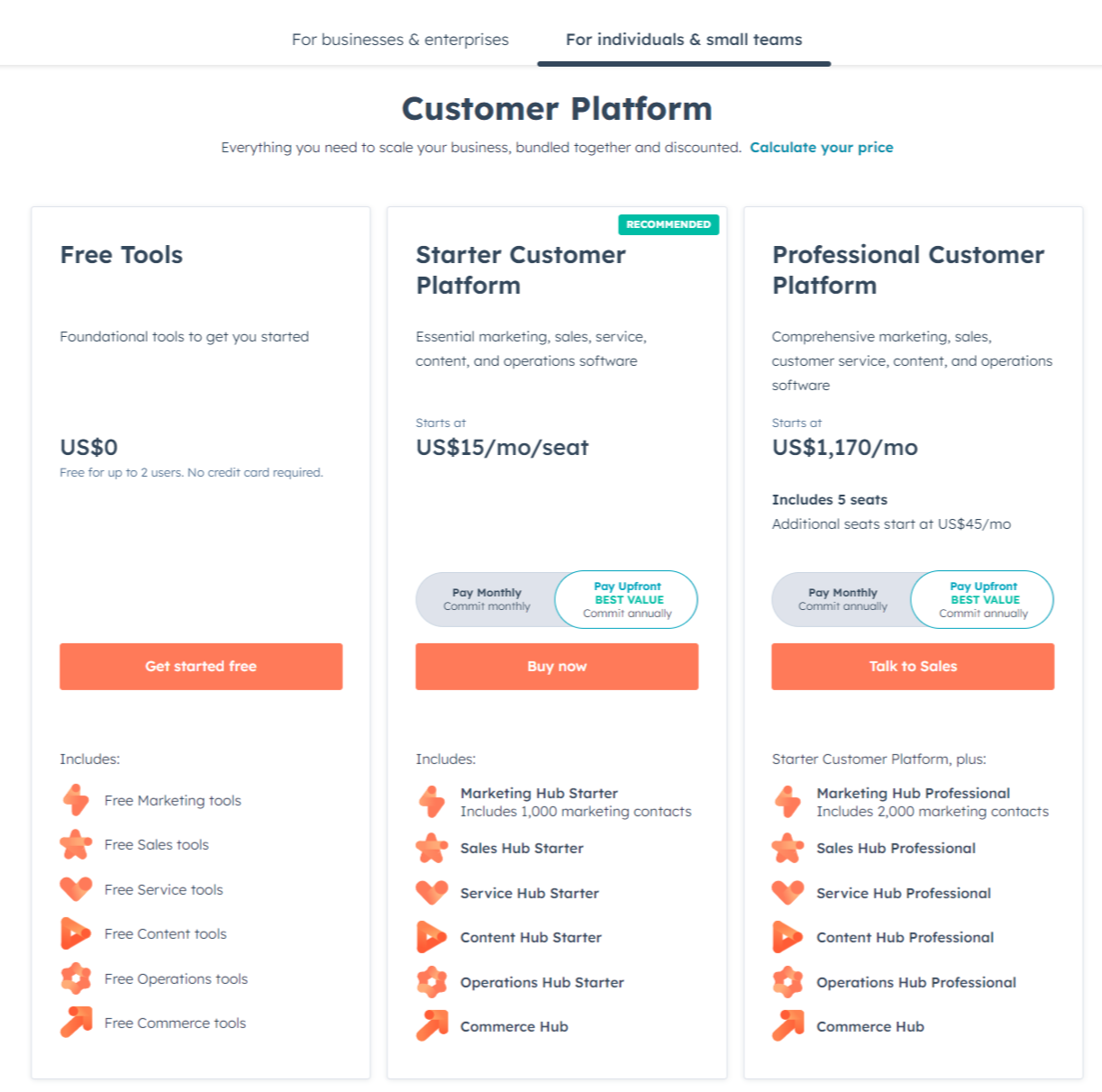
There are three main plans for individuals and small businesses:
- Free plan - $0/month
- Starter Customer Platform - $20/mo/seat
- Professional Customer Platform - $1,300/mo for five seats
For the best value for your business, you can commit to paying for the annual Starter and Professional Customer Platform plans at $15 and $1,170 per month, respectively. Additional seats for the Professional plan start at $45 per seat.
For businesses and enterprises, there are two options to choose from:
- Professional Customer Platform - $1,300/mo for five seats
- Enterprise Customer Platform - $4,300/mo for seven seats
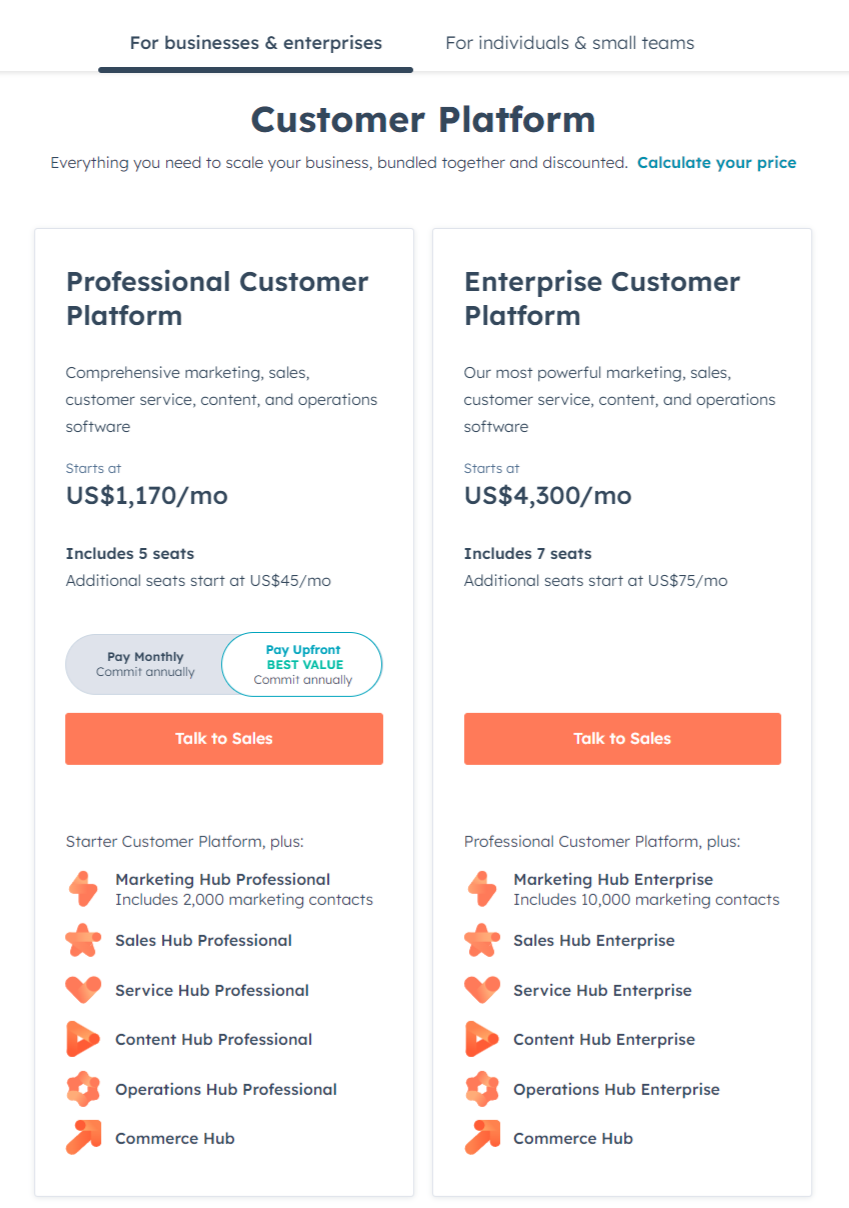
Although these bundled plans offer the best value, you can combine different hubs depending on your business needs. The best strategy is to learn what each plan provides and then jump on the one that makes the most sense for your team.
Benefits and drawbacks of HubSpot CRM
Let's look at what makes HubSpot's CRM worth it, and what may make it unsuitable for your business.
The pros of using HubSpot's CRM system
✔ HubSpot CRM is easy to use
HubSpot's user interface is generally easy to use. The platform also provides free training in the HubSpot Academy.
✔ HubSpot’s free plan is enough for most businesses
HubSpot provides a feature-packed free plan that can help most online businesses with their CRM strategy. Business owners can add up to 1,000 contacts while on the free plan, allowing them to improve customer relationships at no cost.
✔ HubSpot can grow with you
HubSpot provides a series of scalable modular tools. As your business grows, you can gradually improve your customer service, operations, content, sales, and marketing by making the most of these features.
✔ HubSpot has excellent customer support
There is a Help button on most pages that you can click to contact HubSpot support. The support team is available through email, chat, or phone. However, subscribers of the free plan only get support from the HubSpot Community.
✔ You can easily track and measure success
HubSpot data is centralized and lets you control everything from one place. In addition, you can measure your success or shortcomings using key performance indicators (KPIs) provided in the reports section. You can always use this feature to create customized reports to share with your team for action.
The cons of using HubSpot's CRM system
✘ HubSpot’s CRM plans can be costly for some small business owners
Although they often come in handy, HubSpot’s free plans might not offer the best value for your business.
There are limitations on several features, such as the number of seats, automated emails per form, and active lists. Upgrading to the paid plans can significantly increase your budget size.
✘ There is a steep learning curve for advanced features
HubSpot CRM's user interface is generally easy to use. However, building custom websites and automated workflows requires high levels of experience.
Large organizations often hire in-house members to maximize these features, while smaller organizations outsource the work to HubSpot CRM experts.
What are users saying about HubSpot CRM?
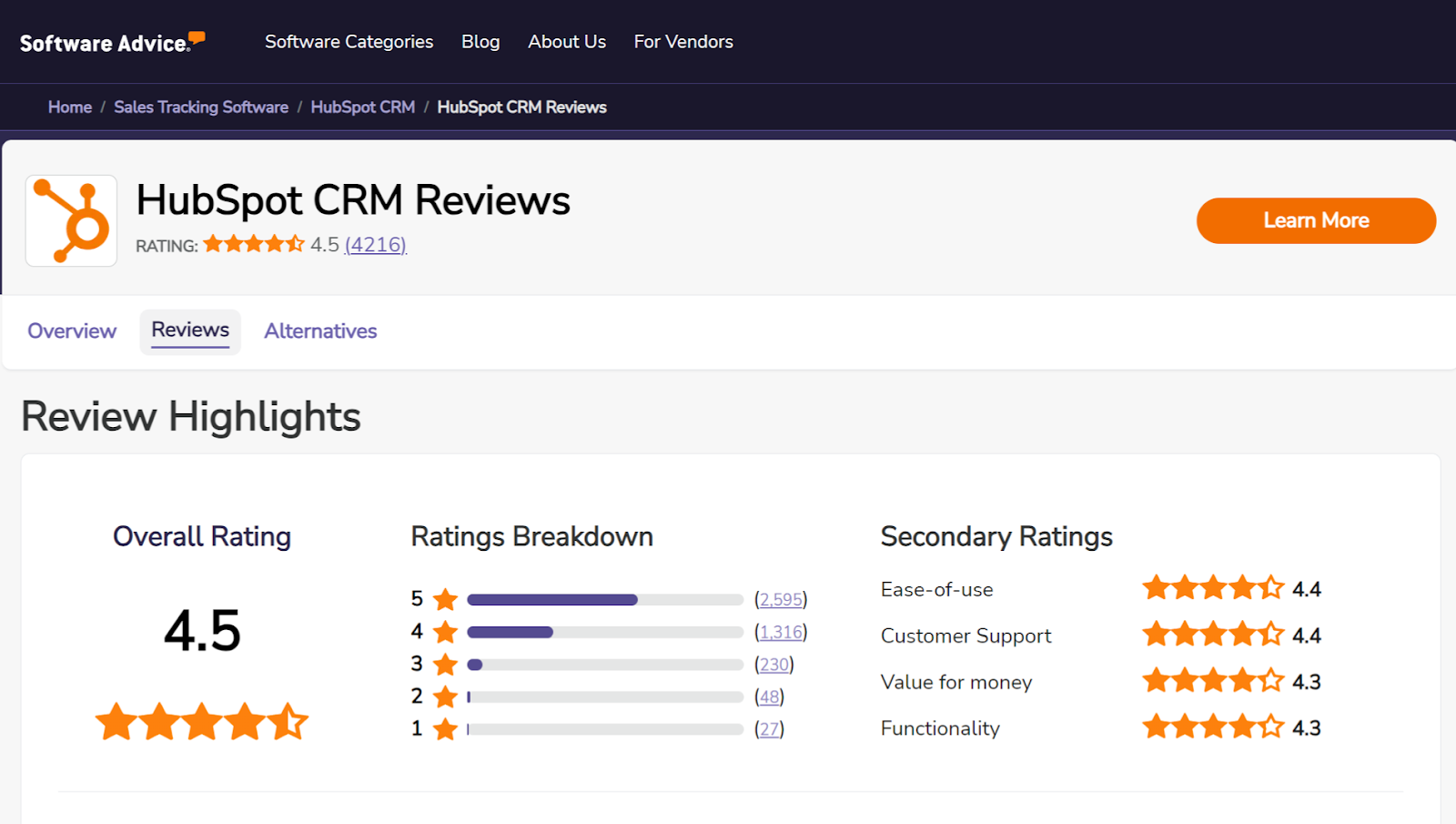
HubSpot CRM mostly has positive ratings on leading review sites. It scores 8.4/10 from 4,396 ratings on TrustRadius and 4.5/5 from 4,216 reviews on Software Advice. On Capterra and G2, the software maintains a score of 4.5/5 based on 4,216 and 11,992 reviews, respectively.
Most positive reviews are about the platform being easy to navigate and valuable features. In her Trustpilot review, Whitney states that HubSpot CRM's tools have been helpful to her clean-up and maintenance company. She also loves HubSpot’s training and courses for new users.
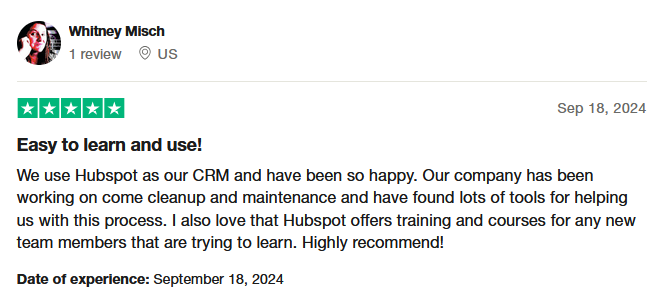
In this review, Rob states that HubSpot’s Marketing Hub helps businesses quickly create landing pages and track campaign results. However, he considers the absence of an auto-translation functionality a downside.
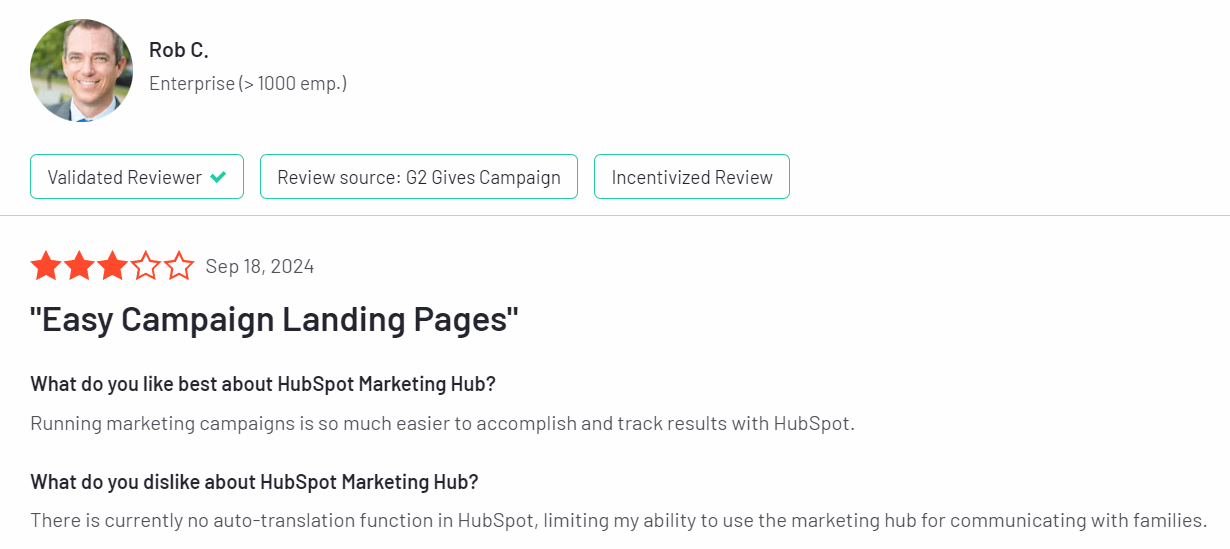
Most of HubSpot’s negative reviews are about high-priced plans that are out of reach for most small and medium-sized businesses. John, the director of a management consulting company, states that the useful features of HubSpot’s CRM are expensive.
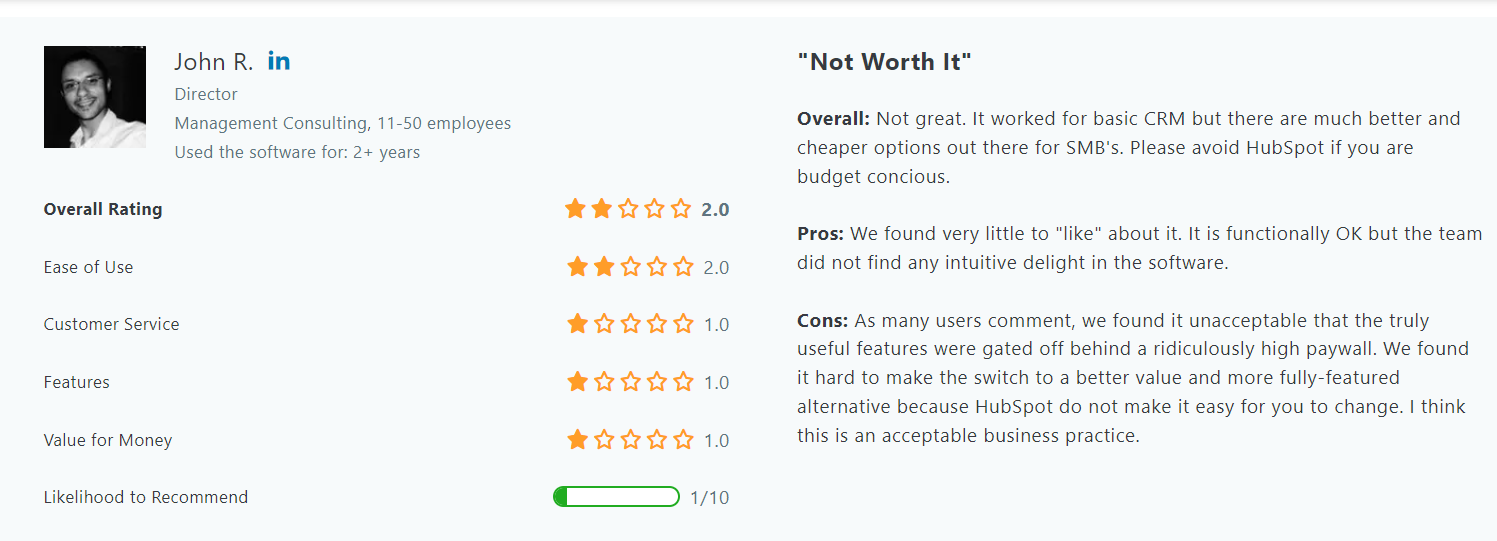
So, is HubSpot CRM a good fit for your business?
From where we stand, HubSpot is a good CRM tool. The platform is suitable for:
- Generating contact records and viewing customer interactions
- Checking customer activities
- Creating deal pipelines
- Handling inquiries
- Qualifying leads
- Sending welcome messages to potential customers
However, a small business owner should work with an expert to get the most out of the advanced features. You will also need to evaluate your business needs, budget, and available resources before settling on a plan that works for you.
HubSpot CRM alternatives you can consider
Whop
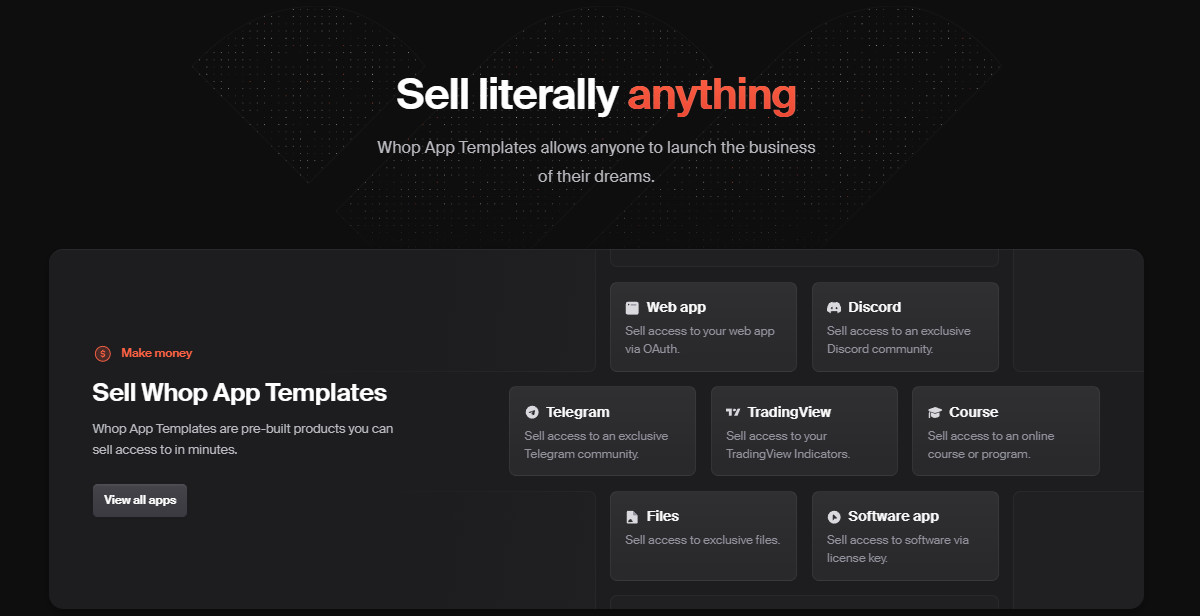
The perfect CRM platform helps retain existing customers and improve sales.
Whop helps you do just that!
Whop provides a dashboard full of amazing CRM tools to help you manage your business and make it profitable. One of these is the customers' tab, which contains quick action tools for efficiently interacting with your customers. You can track your customers' subscription history and easily communicate with them through Whop’s Chat app, Discord, email, or any of their preferred methods.
The awesome filters help you categorize your customers into different segments, making it possible to offer them personalized experiences. You can also easily export your customer list.
Whop is both user- and budget-friendly, with no monthly fees and an easy setup that takes only a few minutes. It's a great all-rounder for ecommerce businesses.
Salesforce
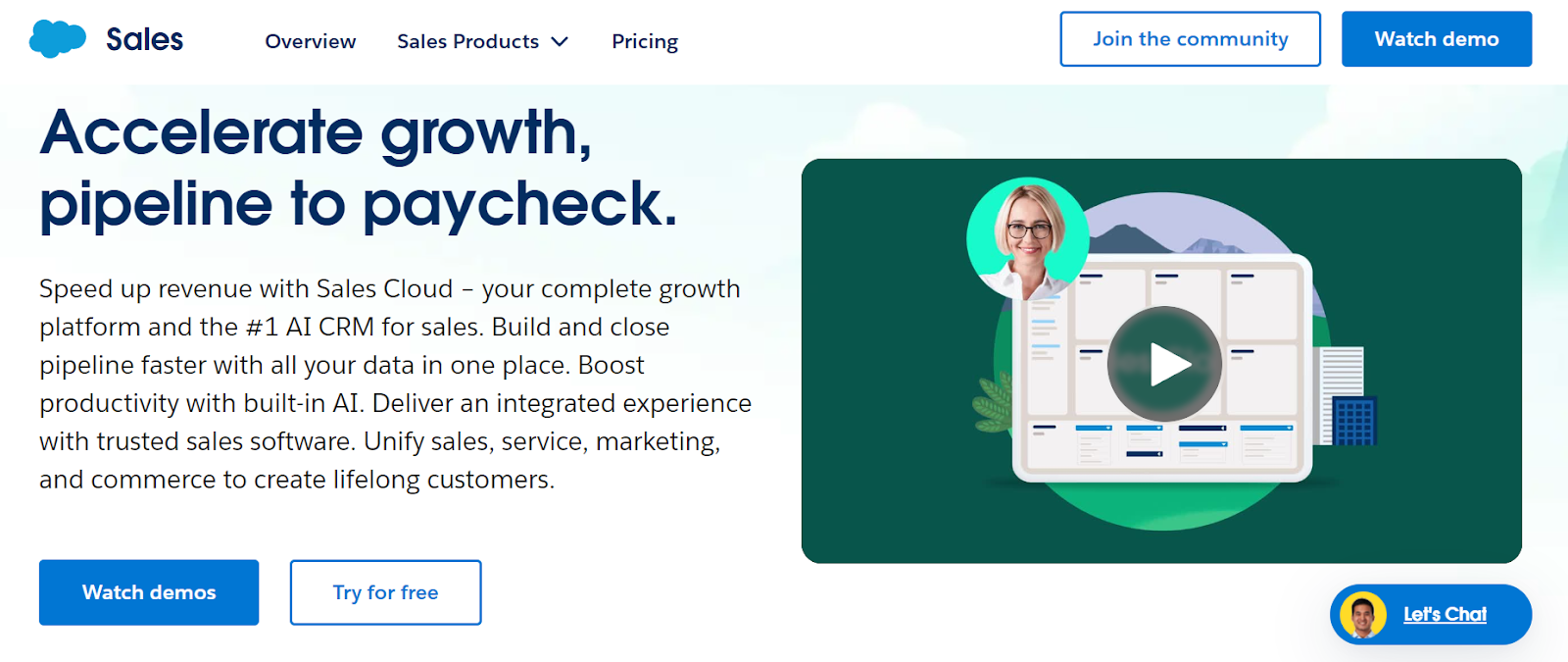
Salesforce is another online CRM software business owners use to find leads, close deals, and connect with their clientele. Like HubSpot, Salesforce centralizes all your data. You can view your service, marketing, commerce, sales, and IT resources in one place, similar to what HubSpot CRM offers.
Based on our analysis, the Salesforce interface is user-friendly. We found creating landing pages on HubSpot easier than on Salesforce. However, Salesforce is more customizable than HubSpot.
HubSpot is also more budget-friendly for small businesses than Salesforce. Salesforce plans start at $180/user/month, considerably higher than HubSpot's Starter Customer Platform, which goes for $20/month/seat.
Based on these differences, we conclude that HubSpot provides a better CRM experience than Salesforce.
Monday.com

Monday.com is a trade-off between a basic functionality and a sophisticated, enterprise-scale customer relationship management solution.
This platform is also user-friendly, relatively affordable, and highly customizable, meaning you can incorporate it into your business as needed. Monday.com has a wide range of features that make it easy to manage leads and communicate with your customers across different channels. Pricing ranges from $12/seat/month to $28/seat/month for a minimum of three members.
When it comes down to choosing between HubSpot CRM and Monday.com, we'd recommend both but for different reasons. HubSpot is ideal for organizations that want to maximize their sales and marketing potential. The platform's primary purpose is to help you capture and manage leads, segment customers, and develop content with the help of AI.
On the other hand, Monday.com is best for small and medium-sized businesses. It simplifies and automates workflows with basic functionality that any business owner can find appealing. However, some of its tools require third-party plug-ins to run.
Pipedrive
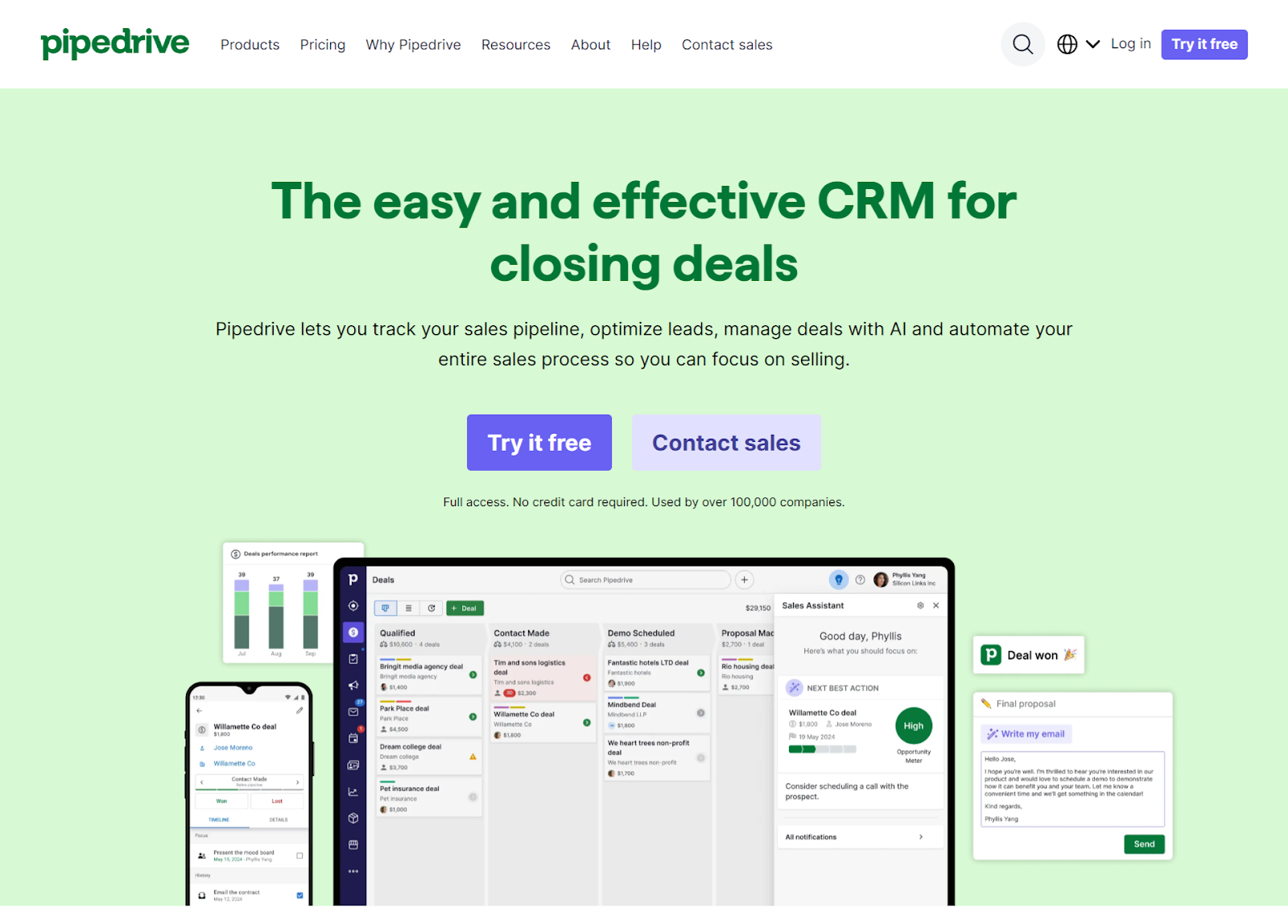
Pipedrive is another CRM platform that targets small and medium-sized businesses. It has all the essential CRM capabilities, such as lead generation and sales tracking, and the ability to consolidate everything in one location.
The platform comes with a very intuitive user interface. There are no messy controls and buttons, which goes a long way in ensuring you stay focused on your work. You can also quickly add new contacts, track the contact timeline, and view all vital information regarding a contact in the form of an attractive visual graph.
Pricing ranges from $24/user/month for Pipedrive Essential to $129/user/month for the Enterprise plan.
All in all, Pipedrive is a very simple-to-use CRM that can support any small business's sales team. However, it doesn't offer a free plan to test its features before committing to a paid plan. It also provides limited customization, and phone support is only available on the most expensive tier.
Improve sales and customer retention with Whop’s CRM tools
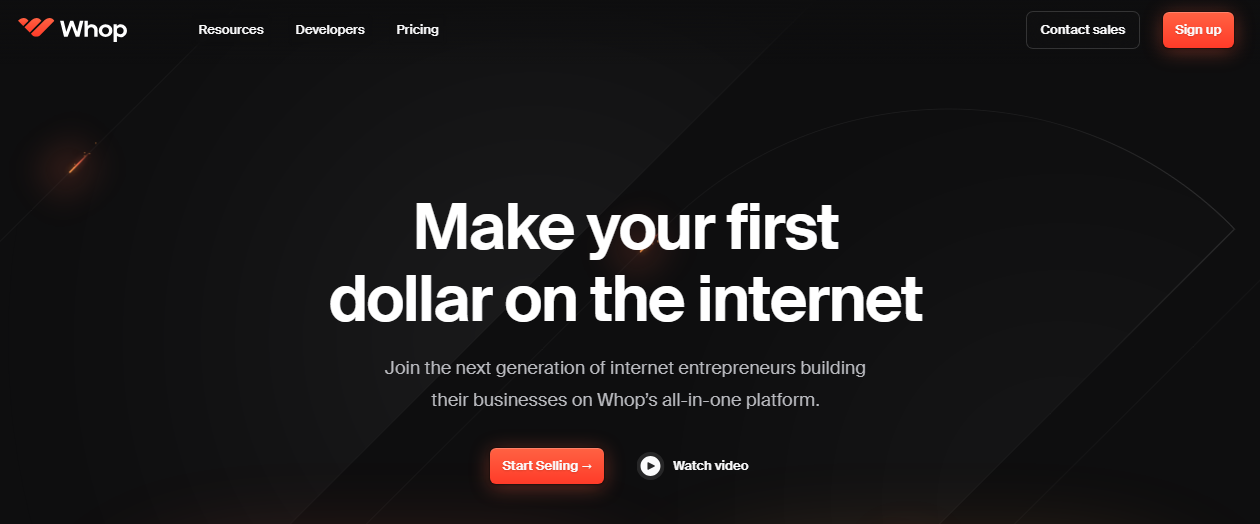
Whop is an all-in-one, highly customizable digital marketplace that helps business owners like you sell all kinds of digital goods and services, including courses, ebooks, software, live coaching, and paid communities. The platform helps you start making money without spending any upfront fees. Whop already has a large community ready to buy your products.
What’s more? There are no monthly fees. Signing up is free, and you only pay a 3% fee when you make a sale.
Once you have decided on the digital product you want to offer, you can start selling on Whop. Getting started is easy and will take you less than 10 minutes. In case you get stuck, Whop’s knowledgeable customer service is available 24/7 to help you.
FAQs
Does your business need a CRM system?
CRM tools are ideal for online business owners who communicate with their clients regularly. Such software can help you manage leads and nurture customer relationships.
What should you look for in a CRM system?
There are many variables to consider, such as pricing, integrations, multiplatform access, sales process tools, and ease of use. Consider what's most important for your business and choose a CRM platform that fits this criterion.
What is HubSpot CRM used for?
HubSpot CRM is used for managing leads, maintaining important contact information, viewing customer interactions, creating deal pipelines, handling inquiries, and more. HubSpot CRM combines sales, commerce, marketing, content creation, service, and operations features to provide a comprehensive experience for business owners.
